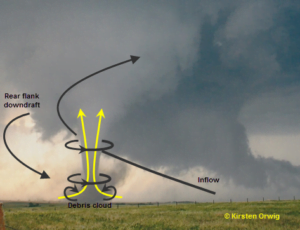News
An ill wind: The birth of a tornado

Tornadoes, despite their destructiveness, have a way of inspiring awe and fascination, perhaps in part because they are still shrouded in mystery. Scientists and engineers have been researching them for decades, but we’re still unsure exactly how they form. It’s clear that key ingredients are needed, but even when all are present, it doesn’t guarantee that tornadogenesis—the birth of a tornado—will occur.
Let’s take a step back and talk about thunderstorms for a moment. There are many different flavors of thunderstorms, such as the dry, short-lived storms of the desert southwest, storms with torrential rains in subtropical Florida, or squall lines with damaging winds (sometimes called derechos) in the Midwest. Each type has its own characteristics and lifecycle that differentiates it from other types of storms. However, it’s the “supercell” thunderstorm that is responsible for most tornadoes.

Supercells have a deep, strong, rotating updraft (the lifeblood of the storm) called the mesocyclone. Such storms tend to form along frontal boundaries in environments of moderate wind shear, where winds at the surface approach from the south or southeast, and winds aloft come from the west or northwest. There also needs to be ample moisture available for the storm to develop and sustain itself. As the warm, moist air rises, it rotates due to wind shear, and most of the precipitation is pushed ahead of the storm in what is called the forward flank downdraft. A second downdraft (the rear flank downdraft) circulates around behind the storm and interacts with the updraft and inflow air. It’s at this point of interaction that, if conditions align properly, a tornado will form.
The anatomy of a tornado is not well understood, as it’s nearly impossible to take measurements from within. Instead, scientists often depend on mobile Doppler radars, but we are still unable to “see” the tornado at ground-level. Therefore, laboratory simulations are often used to ascertain what’s actually going on inside. These simulations suggest that tornadic flow is quite complex, with upward, downward, and (of course) circulating motions. The largest tornadoes also have multi-vortex structures, with individual rotating funnels that circulate around each other. The few observations that do exist from within tornadoes suggest that they have an “eye” at the center, which has very low pressure: much like a hurricane, but on a much smaller scale. This complex flow and intense very rapid pressure changes are what enable tornadoes to be so destructive compared to hurricanes or straight-line winds.


Dr. Kirsten Orwig is an Atmospheric Perils Specialist with Swiss Re, where she leads atmospheric hazards risk assessment modeling and outreach. She developed a new approach to tornado risk assessment modeling, serves on the American Geophysical Union Natural Hazards Focus Group Board and on the Natural Hazard Mitigation Association board. Kirsten has spoken frequently on climate change, severe weather, and catastrophe insurance. She co-authored US Tornadoes: An Examination of the Past to Prepare for the Future, and other publications. Before joining Swiss Re, Kirsten was a Systems Integration Analyst at the National Renewable Energy Laboratory where she led modeling and forecasting research and public/private partnerships to more efficiently integrate wind and solar power onto the nation’s electrical grid. Prior to NREL, she was a Senior Scientist at CPP Inc., where she modeled wind in complex terrain and performed tornado risk assessment. Kirsten holds a B.S. double-major in Chemistry and Physical Science, an M.S. in Atmospheric Science, and she was awarded an NSF IGERT Fellowship to complete her PhD in Wind Science and Engineering. Her research focused on the measurement and characterization of strong winds with implications for building design.
